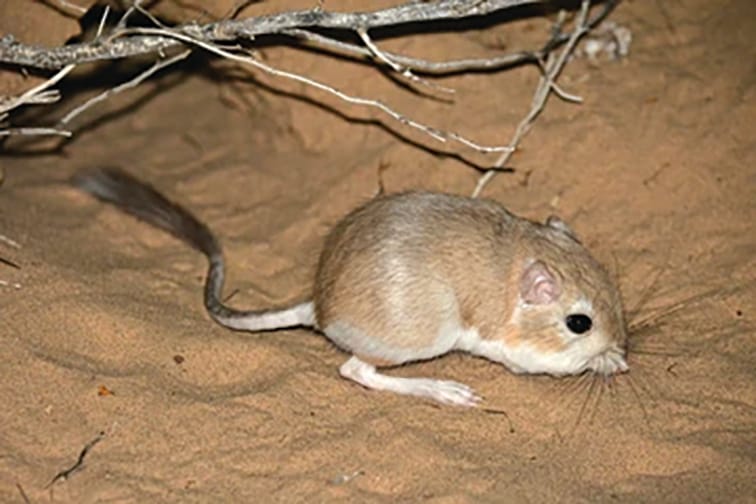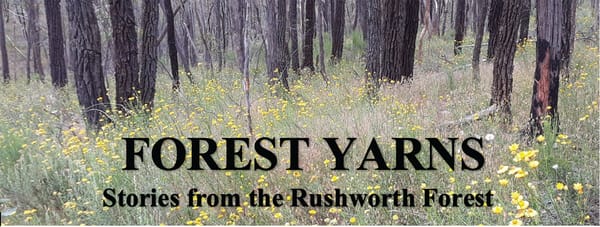Better ways
By Neil Laurie

Originally the scientific gathering of information on Australian wildlife involved shooting or catching it and then preserving and/or drawing it. Our museums are full of stuffed, pickled or dried creatures and their skeletons; the rarer the better. These collections of animal and bird bits are still valuable scientific resources.
Every single bird illustrated in John Gould’s ‘The Birds of Australia’ (over 680 of them) were drawn and painted from shot specimens. It was seen as being acceptable. Today, thanks to modern scientific methods, things are very different. The unfolding search for the presumed to be extinct desert rat-kangaroo (Caulophrynids campestris) is an example of how new methods and technologies can be used.
The desert rat-kangaroo lived in the desert country of north-eastern South Australia. It differed from the other species of rat kangaroos and bettongs in that it had a short nose. Like most desert-dwelling species it was sparsely spread across its range and rarely seen.
It was first recorded in the early 1840s The arrival of feral cats and foxes saw a sharp decline in its numbers and it was presumed extinct by 1850.
In 1931 a colony of them was discovered which ultimately died out. The last confirmed record of the desert rat-kangaroo was in 1935. It was officially declared extinct in 1994.
There is tantalising evidence that there are still some rat-kangaroos out in the desert. There were unconfirmed sightings in the mid 1950s and again in the mid 1970s after wet years.
In 1985 some remains were found in a cave. There have been other unconfirmed sightings. However, there has been no irrefutable proof that the desert rat-kangaroo is still in existence. It is not surprising that the rat-kangaroo has not been found; several other similar species have been rediscovered after being presumed extinct. The hard part is finding such a rare nocturnal animal in a vast area of desert. It is going to require a concerted effort using new approaches and the latest technologies.
The first step is to look for areas that have vegetation suitable for the desert rat-kangaroos to eat. It was assumed that with its short jaws it could only eat soft vegetation.
A biomechanical study of skulls by Flinders University has discovered the opposite is true; the short jaws allowed
them to eat woody plants. The plan is to use satellite imagery to locate areas of suitable woody vegetation and habitat.
These areas can then be surveyed at ground level. Like other rat-kangaroos and bettongs, the desert rat-kangaroo builds a sheltered nest of sticks. Although nests are difficult to spot from the air, the use of drones could make searching for the nests more efficient.
Any scats (poo) discovered can be analysed for DNA of the rat-kangaroo. The analysis of small scats has in the past been inconclusive. Dingo, fox and cat scats can also be analysed for the presence of desert rat-kangaroo DNA.
Once an area has been identified as probably having desert rat-kangaroos, researchers can use spotlights at night to search for them. Another search method is to use trail cameras. These have become quite cheap. They are triggered by sensing motion and also can record in the infra-red, giving them night vision. Some record footage onto a SD card. Others send footage via a mobile network. They have a number of advantages: they give 24-hour, seven day a week surveillance, they allow a researcher to watch multiple sites simultaneously and they also record other animals. They give a more comprehensive understanding of the ecology of the area; very important if dingoes, foxes or cats are captured by the cameras.
Should desert kangaroo-rats be discovered, a more intense study can be carried out and conservation strategies developed. Establishing predator-free enclosures and captive breeding programs (strategies that worked with the greater bilby) are likely outcomes.
The days of walking around and shooting wildlife for science are long gone, replaced by better ways of studying them. There is a certain irony that the desert rat-kangaroo was first described in London by John Gould using three preserved specimens sent to him by George Grey, the Governor of South Australia. It remains to be seen if this extinct species really is extinct or if it is another ‘Lazarus species’.










